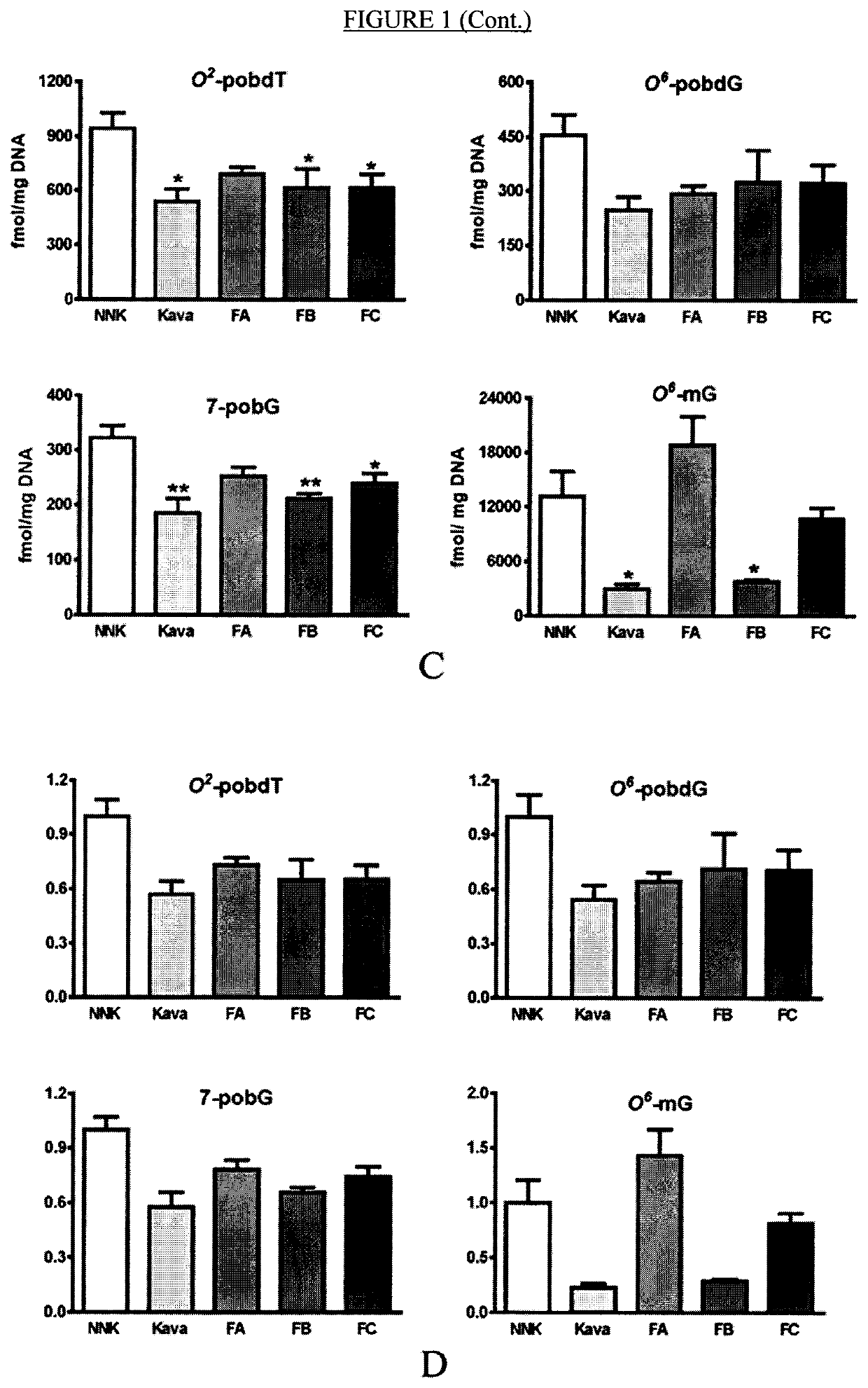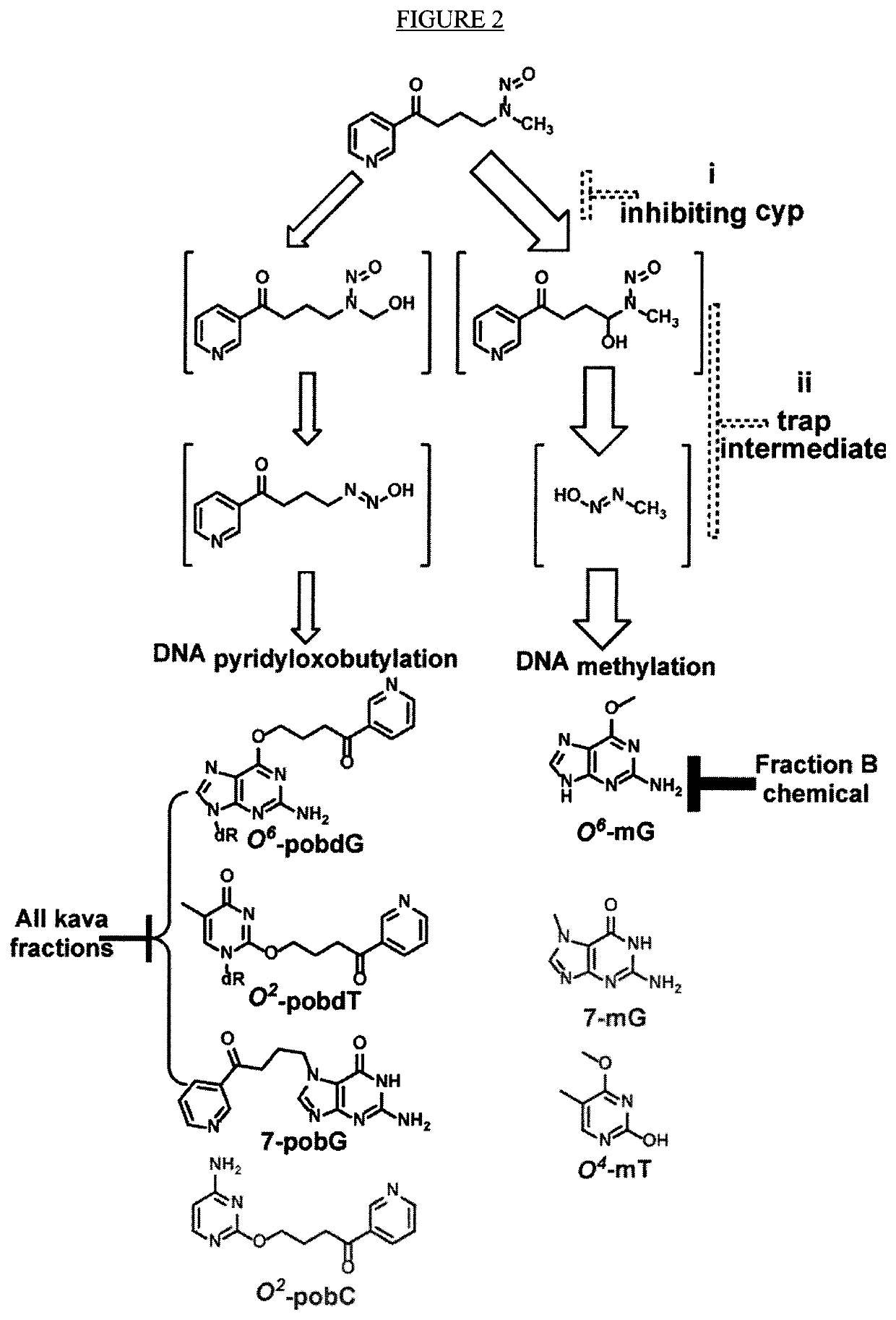Kava derived therapeutic compounds and methods of use thereof
a technology of kava and therapeutic compounds, applied in the direction of drug compositions, plant/algae/fungi/lichens ingredients, organic active ingredients, etc., can solve the problems of limited progress in reducing tobacco use, malignancy-related mortality, and the two-carcinogen model does not provide a feasible system to tackle the question of kava's underlying mechanisms and responsible chemicals. , to achieve the effect of reducing dna damage, preventing tumorigenesis
- Summary
- Abstract
- Description
- Claims
- Application Information
AI Technical Summary
Benefits of technology
Problems solved by technology
Method used
Image
Examples
example 1
[0357]As described herein, the tumorigenesis-stage specificity of kava, the potential active compounds, and the underlying mechanisms in NNK-induced lung tumorigenesis in A / J mice has now been investigated. In the first experiment, NNK-treated mice were given diets containing kava at a dose of 5 mg / g of diet during different periods. Kava treatments covering the initiation stage reduced the multiplicity of lung adenomas by ˜99%. A minimum effective dose is yet to be defined because kava at two lower dosages (2.5 and 1.25 mg / g of diet) were equally effective as 5 mg / g of diet in complete inhibiting lung adenoma formation. Daily gavage of kava (one before, during, and after NNK treatment) completely blocked lung adenoma formation as well. Kavalactone-enriched Fraction B fully recapitulated kava's chemopreventive efficacy while kavalactone-free Fractions A and C were much less effective. Mechanistically, kava and Fraction B reduced NNK-induced DNA damage in lung tissues with a unique a...
example 2
Effect of Dietary Kava Fraction B Supplement on Carcinogenesis in Transgenic Adenocarcinoma of the Mouse Prostate (TRAMP) Mice
Introduction of the Model
[0389]In the TRAMP model, the rat probasin promoter drives transgenic “prostate-specific” expression of simian virus 40 (SV40) T-antigen (T-Ag) and small t-antigen; T-Ag binds and inactivates the retinoblastoma (Rb) and p53 tumor suppressor genes; and small t-antigen also drives cell proliferation (Greenberg et al, PNAS, 1995).
[0390]There are at least 2 distinct lineages of carcinogenesis in this model (Chiaverotti et al, Am J Pathol, 2008; Huss et al, Neoplasia, 2007, Wang et al, Prostate, 2011). One lineage is the androgen receptor (AR)-dependent glandular epithelial lesions, which usually involve the dorsal-lateral prostate (DLP) lobes, less for anterior (AP) and ventral (VP) lobes. The other lineage is the AR-independent neuroendocrine (NE)-like poorly differentiated (PD) carcinomas: life-time NE-Ca incidence=⅓ in C57BL / 6 mice, us...
example 3
Effect of Dihydromethysticin and Kava Fraction B on Lung Cancer Treatment in the Xenograft Models
Introduction of the Models
[0393]Cancer xenograft models inoculated using human cancer cell lines have been well-accepted as the animal model to evaluate and develop cancer therapeutic agents. Human H2009 and A549 lung cancer cell lines are two general cancer cell lines for establishing xenograft models. In this example, kava and its modalities, including Fractions A, B, C, dihydromethysticin, and methysticin, have been evaluated for their potential to suppress tumor growth, which support the potential use of these compounds / compositions as therapeutic agents for the treatment of human cancers (see, Example 1 for a description of Fractions A, B and C).
Research Design and Safety Monitoring
[0394]Typically human origin lung cancer cells were cultured and mixed with Metrigel. 2-5×106 cells were inoculated in the nude mice. Mice were randomized into different groups when the tumor size reached...
PUM
| Property | Measurement | Unit |
|---|---|---|
| weight percent | aaaaa | aaaaa |
| weight percent | aaaaa | aaaaa |
| weight percent | aaaaa | aaaaa |
Abstract
Description
Claims
Application Information
 Login to View More
Login to View More - R&D
- Intellectual Property
- Life Sciences
- Materials
- Tech Scout
- Unparalleled Data Quality
- Higher Quality Content
- 60% Fewer Hallucinations
Browse by: Latest US Patents, China's latest patents, Technical Efficacy Thesaurus, Application Domain, Technology Topic, Popular Technical Reports.
© 2025 PatSnap. All rights reserved.Legal|Privacy policy|Modern Slavery Act Transparency Statement|Sitemap|About US| Contact US: help@patsnap.com



